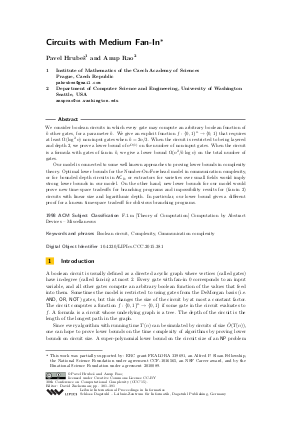Circuits with Medium Fan-In
Authors Pavel Hrubes, Anup Rao
-
Part of:
Volume:
30th Conference on Computational Complexity (CCC 2015)
Part of: Series: Leibniz International Proceedings in Informatics (LIPIcs)
Part of: Conference: Computational Complexity Conference (CCC) - License:
 Creative Commons Attribution 3.0 Unported license
Creative Commons Attribution 3.0 Unported license
- Publication Date: 2015-06-06
File

PDF
LIPIcs.CCC.2015.381.pdf
- Filesize: 488 kB
- 11 pages
Document Identifiers
Subject Classification
Keywords
- Boolean circuit
- Complexity
- Communication Complexity
Metrics
- Access Statistics
-
Total Accesses (updated on a weekly basis)
0Document
0Metadata
Abstract
We consider boolean circuits in which every gate may compute an arbitrary boolean function of k other gates, for a parameter k. We give an explicit function $f:{0,1}^n -> {0,1} that requires at least Omega(log^2(n)) non-input gates when k = 2n/3. When the circuit is restricted to being layered and depth 2, we prove a lower bound of n^(Omega(1)) on the number of non-input gates. When the circuit is a formula with gates of fan-in k, we give a lower bound Omega(n^2/k*log(n)) on the total number of gates.
Our model is connected to some well known approaches to proving lower bounds in complexity theory. Optimal lower bounds for the Number-On-Forehead model in communication complexity, or for bounded depth circuits in AC_0, or extractors for varieties over small fields would imply strong lower bounds in our model. On the other hand, new lower bounds for our model would prove new time-space tradeoffs for branching programs and impossibility results for (fan-in 2) circuits with linear size and logarithmic depth. In particular, our lower bound gives a different proof for a known time-space tradeoff for oblivious branching programs.
Cite As Get BibTex
Pavel Hrubes and Anup Rao. Circuits with Medium Fan-In. In 30th Conference on Computational Complexity (CCC 2015). Leibniz International Proceedings in Informatics (LIPIcs), Volume 33, pp. 381-391, Schloss Dagstuhl – Leibniz-Zentrum für Informatik (2015)
https://doi.org/10.4230/LIPIcs.CCC.2015.381
BibTex
@InProceedings{hrubes_et_al:LIPIcs.CCC.2015.381,
author = {Hrubes, Pavel and Rao, Anup},
title = {{Circuits with Medium Fan-In}},
booktitle = {30th Conference on Computational Complexity (CCC 2015)},
pages = {381--391},
series = {Leibniz International Proceedings in Informatics (LIPIcs)},
ISBN = {978-3-939897-81-1},
ISSN = {1868-8969},
year = {2015},
volume = {33},
editor = {Zuckerman, David},
publisher = {Schloss Dagstuhl -- Leibniz-Zentrum f{\"u}r Informatik},
address = {Dagstuhl, Germany},
URL = {https://drops.dagstuhl.de/entities/document/10.4230/LIPIcs.CCC.2015.381},
URN = {urn:nbn:de:0030-drops-50528},
doi = {10.4230/LIPIcs.CCC.2015.381},
annote = {Keywords: Boolean circuit, Complexity, Communication Complexity}
}
Author Details
References
-
Miklós Ajtai. Determinism versus nondeterminism for linear time RAMs with memory restrictions. Journal of Computer and System Sciences, 65(1):2-37, 2002.

-
Noga Alon and Wolfgang Maass. Meanders, ramsey theory and lower bounds for branching programs. In Proceedings of the 27th Annual Symposium on Foundations of Computer Science, FOCS, pages 410-417, 1986.

-
László Babai, Noam Nisan, and Mario Szegedy. Multiparty protocols, pseudorandom generators for logspace, and time-space trade-offs. J. Comput. Syst. Sci, 45(2):204-232, 1992.

-
David A. Mix Barrington. Bounded-width polynomial-size branching programs recognize exactly those languages in NC¹. J. Comput. Syst. Sci, 38(1):150-164, 1989.

-
Paul Beame, Paraschos Koutris, and Dan Suciu. Communication steps for parallel query processing. In Proceedings of the 32nd ACM Symposium on Principles of Database Systems, PODS, pages 273-284, 2013.

-
Paul Beame and Erik Vee. Time-space tradeoffs, multiparty communication complexity, and nearest-neighbor problems. In Proceedings on 34th Annual ACM Symposium on Theory of Computing, STOC, pages 688-697, 2002.

-
Allan Borodin, Alexander A. Razborov, and Roman Smolensky. On lower bounds for read-K-times branching programs. Computational Complexity, 3:1-18, 1993.

-
A. Chandra, M. Furst, and R. Lipton. Multi-party protocols. In Proceedings of the 15th Annual ACM Symposium on Theory of computing, STOC, pages 94-99, 1983.

-
D. Y. Cherukhin. The lower estimate of complexity in the class of schemes of depth 2 without restrictions on a basis. Moscow University Mathematics Bulletin, 60(4):42-44, 2005.

-
Pierre Deligne. La conjecture de Weil : I, 1974.

-
Zeev Dvir. Extractors for varieties. Computational Complexity, 21(4):515-572, 2012.

-
Oded Goldreich and Avi Wigderson. On the size of depth-three boolean circuits for computing multilinear functions. Electronic Colloquium on Computational Complexity, ECCC, 2013.

-
Johan Hastad. Almost optimal lower bounds for small depth circuits. In Proceedings of the 18th Annual ACM Symposium on Theory of Computing, STOC, pages 6-20, 1986.

-
S. Jukna. Extremal combinatorics, with applications in computer science. Springer-Verlag, 2001.

-
E. I. Nechiporuk. A boolean function. Sov.Math.Dokl., 7(4):999-1000, 1966.

-
Elizaveta Okolnishnikova. On lower bounds for branching programs. Siberian Advances in Mathematics, 3(1):152-166, 1993.

-
P. Pudlák, V. Ro\"dl, and J. Sgall. Boolean circuits, tensor ranks, and communication complexity. SIAM J. Comput., 26(3):605-633, 1997.

-
J. Radhakrishnan and A. Ta-Shma. Bounds for dispersers, extractors, and depth-two superconcentrators. SIAM J. Discrete Math. 13(1): 2-24, 13(1):2-24, 200.

-
Alexander Razborov. Lower bounds on the size of bounded depth circuits over a complete basis with logical addition. MATHNASUSSR: Mathematical Notes of the Academy of Sciences of the USSR, 41, 1987.

-
Roman Smolensky. Algebraic methods in the theory of lower bounds for Boolean circuit complexity. In Proceedings of the 19th Annual ACM Symposium on Theory of Computing, STOC, pages 77-82, 1987.

-
Leslie G. Valiant. Graph-theoretic arguments in low-level complexity. In Mathematical Foundations of Computer Science, MFCS, volume 53 of Lecture Notes in Computer Science, pages 162-176, 1977.

